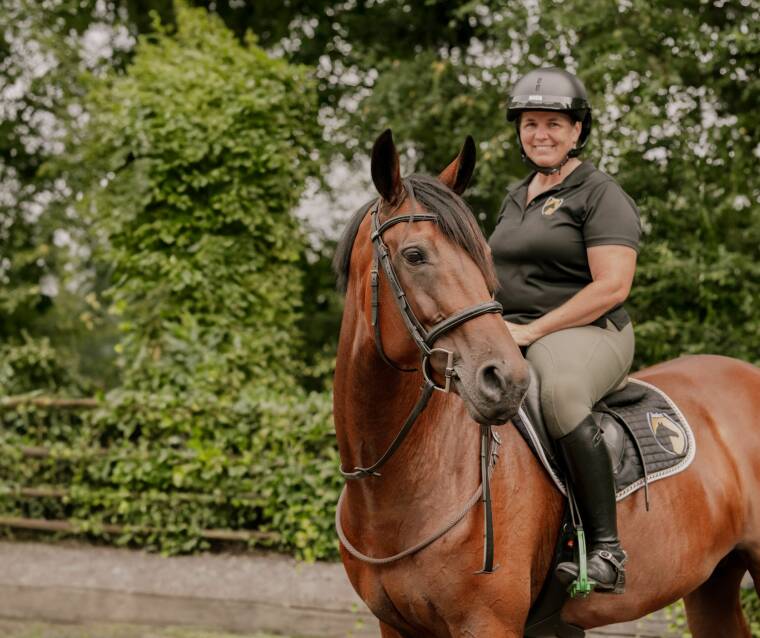Bianca does not have her own horses anylonger, but she helps clients and rides other people's horses.
As a three-year-old Bianca rode the unbroken two-year-old Shetland stallion.
“You are not stronger than your horse, so you have to communicate, you have to ask.”


Riding without a bridle requires that the rider uses aids like the seat, legs and voice, instead of the reins.
It will be more difficult for young horses to collect as they often lack power and balance, which is to come. Having a rider on top can make it even more difficult to balance and will obviously add extra weight, which is why Bianca Schoenmakers always practise adjusting the strides in a lunge. “The rider will more often than not, cause imbalance on a young horse, because the rider is sitting on the front side of the horse. But a rider can also give more clear communication, but first the horse needs to find the balance on its own.” Bianca Schoenmakers starts off in a headcollar and uses voice aids for clear communication.
She notes: “Only collect a tiny bit and then go to a bigger stride again, as long as the power remains. Avoid the horse going tense, so ask for a longer stride, just before the horse tense up. Do not have high expectations and remember to make it enjoyable for the young horse too.”
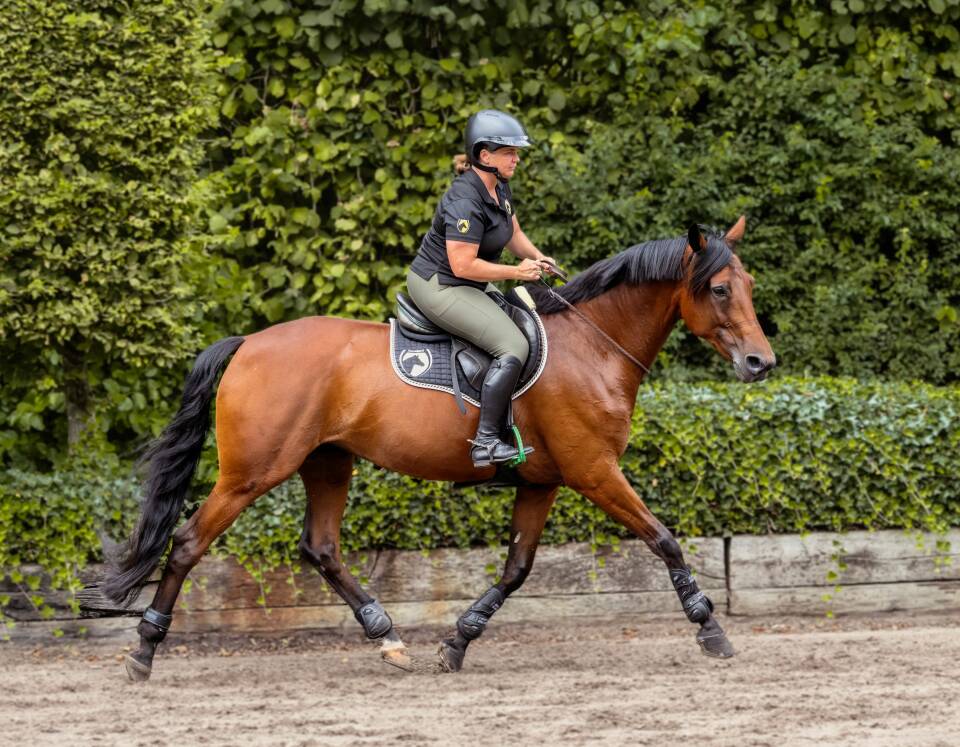
According to FEI: “A half halt is a brief, subtle aid that communicates to the horse to rebalance their weight and prepare for the next movement. It's a combination of multiple aids that are given in quick succession – or even simultaneously.” fei.org
If the horse goes down into a trot
When you are trying to shorten the stride, you may be giving too much of an aid and the horse will fall down into a trot. It may also be, that your horse is behind your leg, or the horse is simply not strong enough to collect. According to Bianca Schoenmakers it is essential to do small changes, so the horse will get stronger and feel more comfortable. “Try and feel just before the horse falls down into a trot and ask to go forward just before, even though the shortening was only for half a stride.”
If the horse runs away from you
When you are trying to lengthen the stride and you experience that your horse runs forward or away from you, it may be because your horse does not understand the task. Go down to a trot or a walk or even the ground to practise the communication for example in a lunge. Practise half halts and make sure you get a light and responsive answer. “Sometimes just thinking about going forwards is enough for the horse to react.”
Practise everywhere
Adjusting the canter strides is not only to be trained in an arena, actually you can practise when you go on a hack. Here you have straight lines, it is a different environment, and it may get less boring for both horse and rider. Again, Bianca Schoenmakers emphasized the importance of variety.
You can also train with poles, at every gait. This can really help give both you and your horse a feel of short and long strides and you place the poles further apart or closer to each other. Make small changes, do not challenge your horse, and help it to understand.
Without a bridle
To underline the importance of your seat and leg, Bianca Shcoenmakers also rides without a bridle and is able to collect and shorten the stride without the use of a bit.
“Firstly, your horse needs to be well-trained to ride without a bridle, then use the same signals as with any horse. Lean back a little with your upper body, not much, but mainly with your hip. Think of telling the horse “woo” with your body. Then I slightly use the neck rope, but again do not take your horse and hold it there, instead squeeze and release. You are not stronger than your horse, so you have to communicate, you have to ask.”
Repeat the shortening and lengthening of the horses’ strides in four to five minutes, then do something else, and practise again later on. The horse needs to understand the task, feel comfortable and confident. We did this before; now I know what to do now. Remember to praise the horse, when it tries its best or does something correct. Bianca Schoenmakers underlines the importance of variety in every type of training. “Don’t do it for an hour, practise on a circle, on a straight line, in trot in canter. Also practise intentional transitions between the gaits.”
“If your horse is not responsive enough, you repeat the aid and then release again. If you release and repeat, you will most likely get a new answer from the horse. But if you give an aid and you hold on to that aid, and the horse does not respond, you will teach the horse to not respond on that aid. The horse will start leaning on your hand and go against your leg to get away from the pressure that is the aid"

According to FEI: “A half halt is a brief, subtle aid that communicates to the horse to rebalance their weight and prepare for the next movement. It's a combination of multiple aids that are given in quick succession – or even simultaneously.” fei.org
Try not to block the horse with your hands like in this photo. As you can see, the horse will become tense, uncomfortable and not using its body correctly.
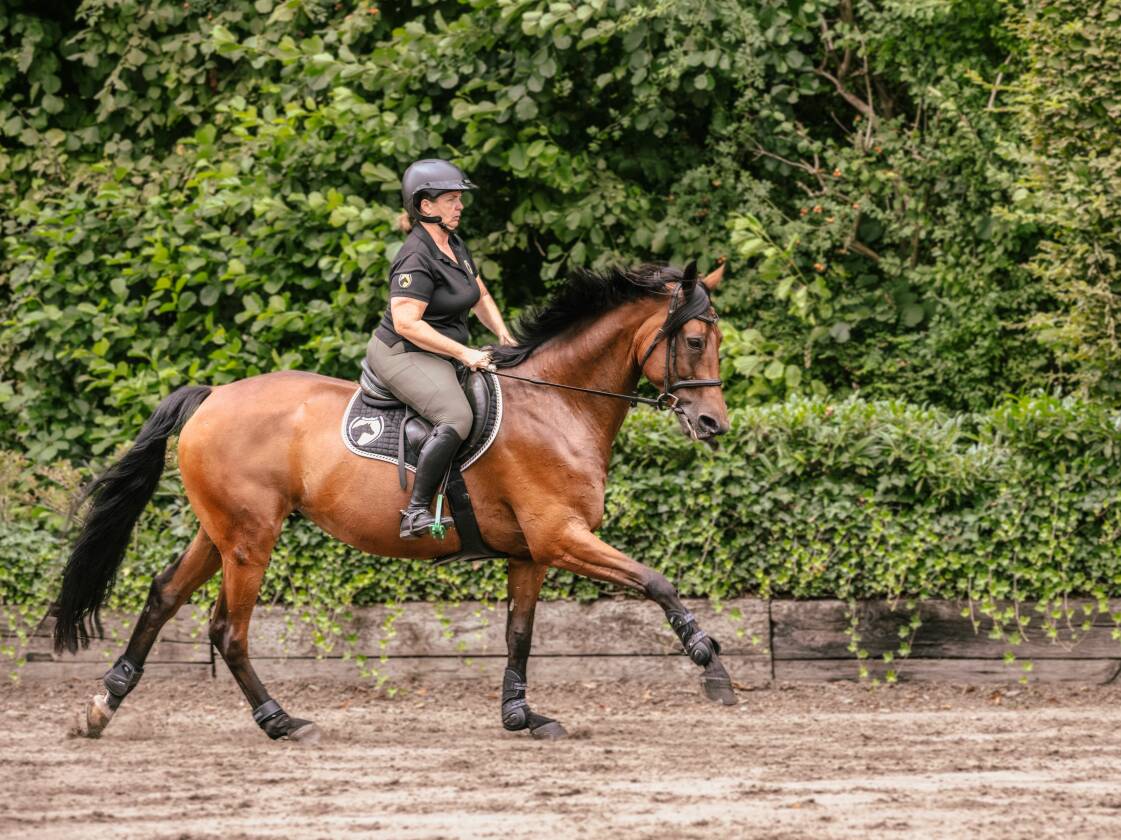
Instead of the rider providing correct half halts, I see riders that block their hands and try to hold the horse in the reins. The rider keeps on pushing with their seat and leg to keep the canter, but the horse is completely tense in its whole body. The stride is small, but it is wrong because the horse stops moving through the body.
Once you feel both you and your horse have an understanding of adjusting the strides in trot, move up to a canter, but keep the same idea in mind.
Before you start practising the same as you did in walk and trot, do it on a circle. For most horses canter is the more unbalanced gait and therefore having them on a circle will help with balance and engagement from the hindend. Bianca Schoenmakers notes, that it does not have to perfect at walk and trot before you move up into canter, as long as the both the horse and the rider has a clear understanding of the task.
It is important to start small. Practise one or two strides, then gradually move up to four and five strides.
Get into a trot and do the exact same as described in step 1 and 2. Naturally it should be a little bit easier at a trot because there is more momentum, and it is physically easier for a horse to shorten and extend strides in trot. Here you should really be able to feel the difference in the length of the steps.
Now, practise shortening your horse’s stride at a walk. You want to try and shorten the horses' step but without the tempo getting slower and without losing the power from behind. When asking most horses to shorten their stride, you need your legs and seat to keep the tempo from getting slower. The shorter you go, the more leg you need. Sink deep into the saddle, bring your shoulders up and back. As with lengthening the stride, keep your hands and arm with an elastic feel, that allows the horse some room.
Depending on your horse’s experience, start at a walk. Practise lengthening the strides. To lengthen, close your legs and ask him to move forward with your seat. Keep an even tempo and rhythm. Encourage your horse to stay steady in the bridle by keeping your hands and arms very still with an elastic feel that follows the motion of the horse. Don’t block your horse with your hands.
"The horses started to become factory work for me, I didn’t see the horse as an individual anymore, it was just a whole bunch"


When horses become factory work
At 19, Bianca got a job at a horse dealer and worked there for 17 years. She did international shows and also worked for two other employers in the showjumping industry. At some stage Bianca stopped to enjoy riding ten horses a day, six times a week, which has led her to the lifestyle she lives today. “The horses started to become factory work for me, I didn’t see the horse as an individual anymore, it was just a whole bunch.”
Becoming a part time truck driver, started her own business, being an instructor and not owning a horse herself, is what gives her the variety she needs in her life to be able to enjoy every single ride. Horses that she previously would have regarded as ‘not my type’ horse, now has her full interest. “I just enjoy training horses.” Bianca says.
Bianca has a big following on social media, where she posts unfiltered content about all aspects of horses. She tests products and provides honest information to her followers. She arises issues that often is not dared to speak about and provides clarity for what may be unknown. Bianca has spent most of her time in a jumping saddle but has a thorough understanding of most disciplines and now also trains baroque and dressage horses.
Now, at the age of 41 Bianca still competes and campaigns horses, but she feels more balanced and connected with each horse. When we asked what she thought as an overlooked aspect of training horses, she mentioned being able to shorten and lengthen canter strides.
It all started with a pony...
Bianca Schoenmakers was born into horses, as both her parents were involved with horses. Her mom was also a rider, working in different stables and when Bianca was three years old, her parents bought her an unbroken two-year-old stallion Shetland pony. “My parents had to buy the cheapest pony possible” says Bianca and laughs but reassures that it thought her how to fall – and get back up on the horse.
Why is it important to be able to adjust your canter strides
For showjumping the length of the canter stride is essential to get the right distance towards a jump. Just as important as it is to be able to collect after a jump, to prepare for the next. For dressage it is necessary in the test because it shows obedience, balance and cadence.
Bianca underlines the importance of general gymnastics for every horse, where lengthening and shortening strides are very effective for training the hind legs, haunches, and hips to become stronger. Bianca notes the most important practise of being able to correct the canter stride: “The main thing should be to train your horse to have them responsive to your aids and to train his body in a healthy way. It is like stretching and power training.” This training is important in any discipline to keep the horses’ body flexible, capable and healthy. And it is essential that the horse performs the task correctly.
“The power should always come from the hind end. I often see that people start to collect their horse to make a smaller stride without having the engagement from behind. The horse will become tense in the middle part, over the back. Yes, the stride will become smaller, but it’s not really a stride anymore. The canter has now become a four-step beat, instead of three, as it should be. The rider will get a feeling of getting a smaller stride and that is why this exercise can be quite difficult.” Bianca Schoenmakers.
A tip is to lengthen your horse’s stride on the long sides of the arena, so on the straight line, and ask the horse to shorten its stride on the short ends, and on a circle. Bianca explains why: “It is easier to practise shortening of the stride on a circle as it will help with balance and keep the connection from behind to front.”

“My parents had to buy the cheapest pony possible”


By: Celine Bønnelykke
Photos: Malgré Tout // Natasja Stienstra
It is not easy, but it is such a useful skill for both you and your horse. Being able to correct the length of a canter stride is useful in any disciplines and in many different situations.
Currently based in the Netherlands, Bianca Schoenmakers, has competed at 1.60 meter events throughout Europe and has become a trainer and instructor for all types of riders in all disciplines. She assists us is explaining how to practise your canter stride on any type of horse.
Adjust your canter stride
- with Bianca Schoenmakers


Riding without a bridle requires that the rider uses aids like the seat, legs and voice, instead of the reins.
Try not to block the horse with your hands like in this photo. As you can see, the horse will become tense, uncomfortable and not using its body correctly.
Bianca does not have her own horses anylonger, but she helps clients and rides other people's horses.

As a three-year-old Bianca rode the unbroken two-year-old Shetland stallion.
“You are not stronger than your horse, so you have to communicate, you have to ask.”

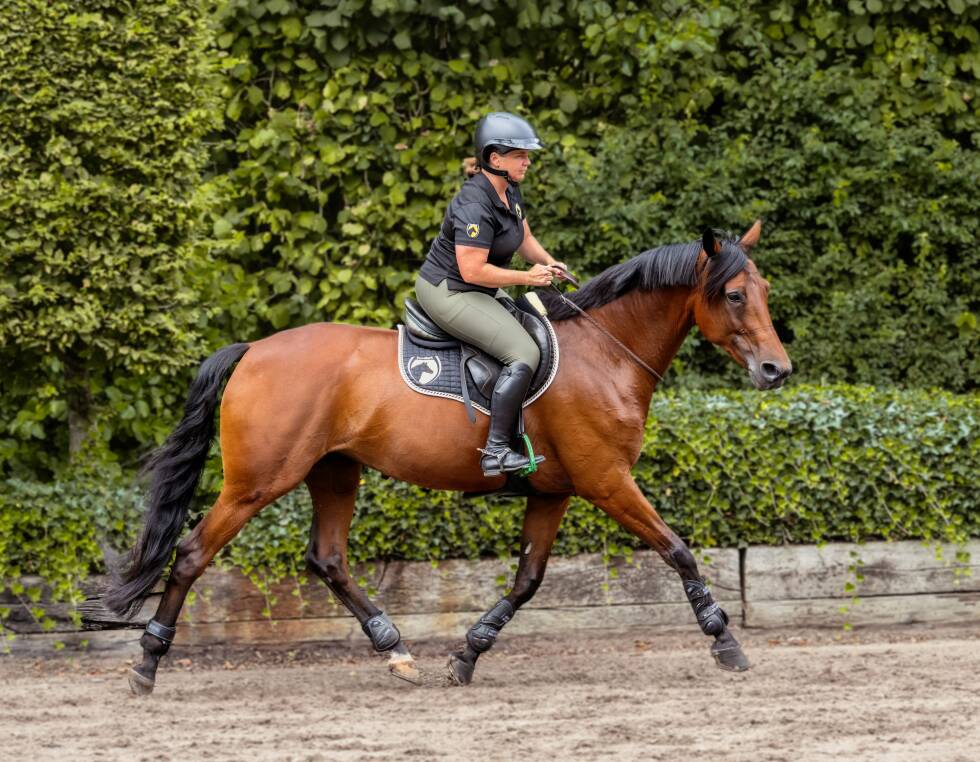
It will be more difficult for young horses to collect as they often lack power and balance, which is to come. Having a rider on top can make it even more difficult to balance and will obviously add extra weight, which is why Bianca Schoenmakers always practise adjusting the strides in a lunge. “The rider will more often than not, cause imbalance on a young horse, because the rider is sitting on the front side of the horse. But a rider can also give more clear communication, but first the horse needs to find the balance on its own.” Bianca Schoenmakers starts off in a headcollar and uses voice aids for clear communication.
She notes: “Only collect a tiny bit and then go to a bigger stride again, as long as the power remains. Avoid the horse going tense, so ask for a longer stride, just before the horse tense up. Do not have high expectations and remember to make it enjoyable for the young horse too.”
According to FEI: “A half halt is a brief, subtle aid that communicates to the horse to rebalance their weight and prepare for the next movement. It's a combination of multiple aids that are given in quick succession – or even simultaneously.” fei.org
Repeat the shortening and lengthening of the horses’ strides in four to five minutes, then do something else, and practise again later on. The horse needs to understand the task, feel comfortable and confident. We did this before; now I know what to do now. Remember to praise the horse, when it tries its best or does something correct. Bianca Schoenmakers underlines the importance of variety in every type of training. “Don’t do it for an hour, practise on a circle, on a straight line, in trot in canter. Also practise intentional transitions between the gaits.”
According to FEI: “A half halt is a brief, subtle aid that communicates to the horse to rebalance their weight and prepare for the next movement. It's a combination of multiple aids that are given in quick succession – or even simultaneously.” fei.org
If the horse goes down into a trot
When you are trying to shorten the stride, you may be giving too much of an aid and the horse will fall down into a trot. It may also be, that your horse is behind your leg, or the horse is simply not strong enough to collect. According to Bianca Schoenmakers it is essential to do small changes, so the horse will get stronger and feel more comfortable. “Try and feel just before the horse falls down into a trot and ask to go forward just before, even though the shortening was only for half a stride.”
If the horse runs away from you
When you are trying to lengthen the stride and you experience that your horse runs forward or away from you, it may be because your horse does not understand the task. Go down to a trot or a walk or even the ground to practise the communication for example in a lunge. Practise half halts and make sure you get a light and responsive answer. “Sometimes just thinking about going forwards is enough for the horse to react.”
Practise everywhere
Adjusting the canter strides is not only to be trained in an arena, actually you can practise when you go on a hack. Here you have straight lines, it is a different environment, and it may get less boring for both horse and rider. Again, Bianca Schoenmakers emphasized the importance of variety.
You can also train with poles, at every gait. This can really help give both you and your horse a feel of short and long strides and you place the poles further apart or closer to each other. Make small changes, do not challenge your horse, and help it to understand.
Without a bridle
To underline the importance of your seat and leg, Bianca Shcoenmakers also rides without a bridle and is able to collect and shorten the stride without the use of a bit.
“Firstly, your horse needs to be well-trained to ride without a bridle, then use the same signals as with any horse. Lean back a little with your upper body, not much, but mainly with your hip. Think of telling the horse “woo” with your body. Then I slightly use the neck rope, but again do not take your horse and hold it there, instead squeeze and release. You are not stronger than your horse, so you have to communicate, you have to ask.”
“If your horse is not responsive enough, you repeat the aid and then release again. If you release and repeat, you will most likely get a new answer from the horse. But if you give an aid and you hold on to that aid, and the horse does not respond, you will teach the horse to not respond on that aid. The horse will start leaning on your hand and go against your leg to get away from the pressure that is the aid"

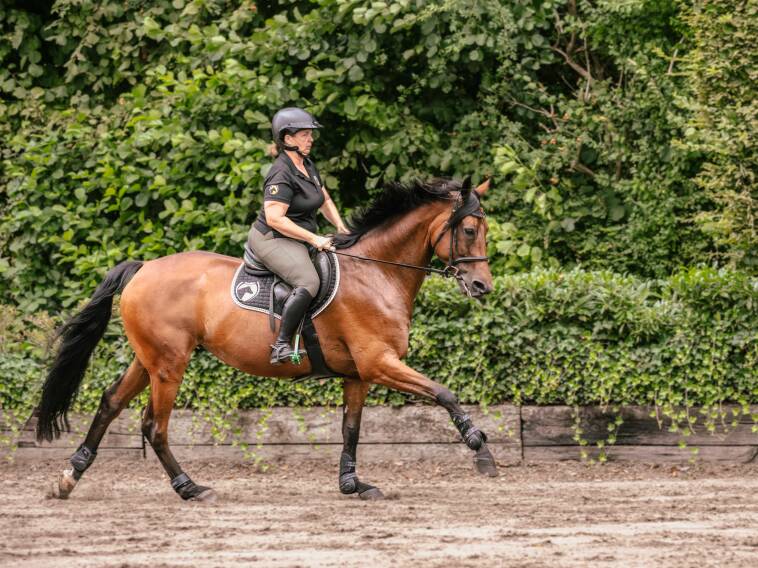
Instead of the rider providing correct half halts, I see riders that block their hands and try to hold the horse in the reins. The rider keeps on pushing with their seat and leg to keep the canter, but the horse is completely tense in its whole body. The stride is small, but it is wrong because the horse stops moving through the body.
Once you feel both you and your horse have an understanding of adjusting the strides in trot, move up to a canter, but keep the same idea in mind.
Before you start practising the same as you did in walk and trot, do it on a circle. For most horses canter is the more unbalanced gait and therefore having them on a circle will help with balance and engagement from the hindend. Bianca Schoenmakers notes, that it does not have to perfect at walk and trot before you move up into canter, as long as the both the horse and the rider has a clear understanding of the task.
It is important to start small. Practise one or two strides, then gradually move up to four and five strides.
Get into a trot and do the exact same as described in step 1 and 2. Naturally it should be a little bit easier at a trot because there is more momentum, and it is physically easier for a horse to shorten and extend strides in trot. Here you should really be able to feel the difference in the length of the steps.
A tip is to lengthen your horse’s stride on the long sides of the arena, so on the straight line, and ask the horse to shorten its stride on the short ends, and on a circle. Bianca explains why: “It is easier to practise shortening of the stride on a circle as it will help with balance and keep the connection from behind to front.”

Now, practise shortening your horse’s stride at a walk. You want to try and shorten the horses' step but without the tempo getting slower and without losing the power from behind. When asking most horses to shorten their stride, you need your legs and seat to keep the tempo from getting slower. The shorter you go, the more leg you need. Sink deep into the saddle, bring your shoulders up and back. As with lengthening the stride, keep your hands and arm with an elastic feel, that allows the horse some room.
Depending on your horse’s experience, start at a walk. Practise lengthening the strides. To lengthen, close your legs and ask him to move forward with your seat. Keep an even tempo and rhythm. Encourage your horse to stay steady in the bridle by keeping your hands and arms very still with an elastic feel that follows the motion of the horse. Don’t block your horse with your hands.
"The horses started to become factory work for me, I didn’t see the horse as an individual anymore, it was just a whole bunch"

Why is it important to be able to adjust your canter strides
For showjumping the length of the canter stride is essential to get the right distance towards a jump. Just as important as it is to be able to collect after a jump, to prepare for the next. For dressage it is necessary in the test because it shows obedience, balance and cadence.
Bianca underlines the importance of general gymnastics for every horse, where lengthening and shortening strides are very effective for training the hind legs, haunches, and hips to become stronger. Bianca notes the most important practise of being able to correct the canter stride: “The main thing should be to train your horse to have them responsive to your aids and to train his body in a healthy way. It is like stretching and power training.” This training is important in any discipline to keep the horses’ body flexible, capable and healthy. And it is essential that the horse performs the task correctly.
“The power should always come from the hind end. I often see that people start to collect their horse to make a smaller stride without having the engagement from behind. The horse will become tense in the middle part, over the back. Yes, the stride will become smaller, but it’s not really a stride anymore. The canter has now become a four-step beat, instead of three, as it should be. The rider will get a feeling of getting a smaller stride and that is why this exercise can be quite difficult.” Bianca Schoenmakers.
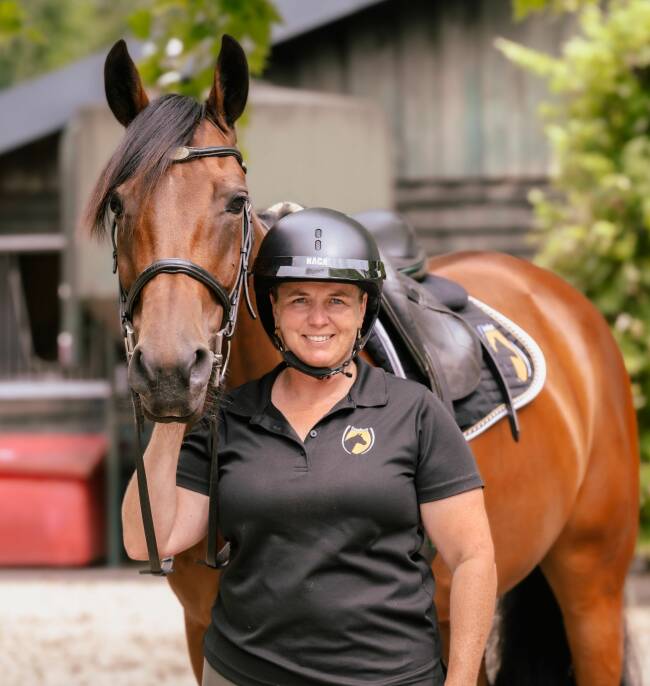
When horses become factory work
At 19, Bianca got a job at a horse dealer and worked there for 17 years. She did international shows and also worked for two other employers in the showjumping industry. At some stage Bianca stopped to enjoy riding ten horses a day, six times a week, which has led her to the lifestyle she lives today. “The horses started to become factory work for me, I didn’t see the horse as an individual anymore, it was just a whole bunch.”
Becoming a part time truck driver, started her own business, being an instructor and not owning a horse herself, is what gives her the variety she needs in her life to be able to enjoy every single ride. Horses that she previously would have regarded as ‘not my type’ horse, now has her full interest. “I just enjoy training horses.” Bianca says.
Bianca has a big following on social media, where she posts unfiltered content about all aspects of horses. She tests products and provides honest information to her followers. She arises issues that often is not dared to speak about and provides clarity for what may be unknown. Bianca has spent most of her time in a jumping saddle but has a thorough understanding of most disciplines and now also trains baroque and dressage horses.
Now, at the age of 41 Bianca still competes and campaigns horses, but she feels more balanced and connected with each horse. When we asked what she thought as an overlooked aspect of training horses, she mentioned being able to shorten and lengthen canter strides.
It all started with a pony...
Bianca Schoenmakers was born into horses, as both her parents were involved with horses. Her mom was also a rider, working in different stables and when Bianca was three years old, her parents bought her an unbroken two-year-old stallion Shetland pony. “My parents had to buy the cheapest pony possible” says Bianca and laughs but reassures that it thought her how to fall – and get back up on the horse.
“My parents had to buy the cheapest pony possible”


By: Celine Bønnelykke
Photos: Malgré Tout // Natasja Stienstra
It is not easy, but it is such a useful skill for both you and your horse. Being able to correct the length of a canter stride is useful in any disciplines and in many different situations.
Currently based in the Netherlands, Bianca Schoenmakers, has competed at 1.60 meter events throughout Europe and has become a trainer and instructor for all types of riders in all disciplines. She assists us is explaining how to practise your canter stride on any type of horse.
Adjust your canter stride
- with Bianca Schoenmakers

